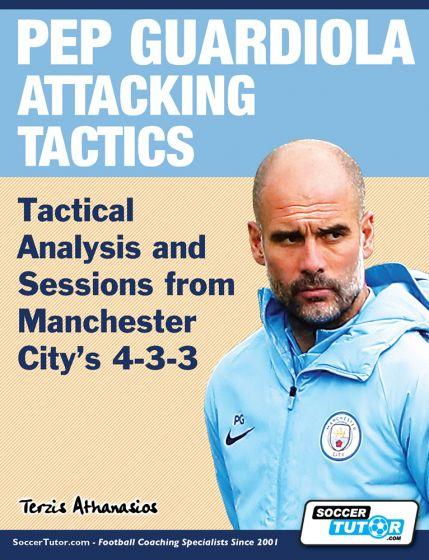Introduction
When discussing football, beating a low block can prove to be one of the most formidable challenges for attacking teams. The low block represents a defensive strategy employed by teams with the intention of confining space, limiting passing options, and challenging their opponents.
In this article, I will delve into effective tactics for overcoming a low block and creating scoring opportunities. These strategies are based on the Positional Play methodology, which has been utilized by notable coaches such as Pep Guardiola , Roberto de Zerbi , Eric Ten Hag with Ajax, and now Manchester United, and many others in recent years.
By understanding the unique characteristics of the low block, analyzing its obstacles, and employing targeted methodologies, teams can increase their chances of success. Two noteworthy examples in this regard are Manchester City and Inter Milan, who were finalists in the UEFA Champions League.
What is the Low Block in Football
The low block is a defensive tactic where the team positions itself deep in its own half, forming a compact defensive shape typically with three lines. The primary objective is to deny the opposition team space in the final third, especially between their own lines, making it difficult to penetrate through the center. Such kinds of teams are strong, with defensive mentality, and with players who love to defend aggressively.
The low block aims to disrupt the opposing team by limiting passing options and closing down spaces near the goal. The defending team maintains a disciplined structure, with players positioned close together, making it challenging for an offensive player to find gaps or exploit vulnerabilities. The team that uses a low block to defend usually relies on a quick counter attack to catch opponents off-guard.
The low block structure typically consists of 5 – 3 – 2, 4 – 4 – 2, or 4 – 5 – 1 formation, or similar variations. It includes three lines with at least one line having four or five players. This rule ensures coverage across the entire width of the field and at least one player on each side to protect the wide lanes.

Analyzing the Challenges of Facing a Low Block
The compact defensive structure of a low block significantly reduces the available space for attacking teams to operate. This limitation restricts passing options and forces the opposing team to try to attack through the wide lanes. It requires fast ball circulation, intelligent movement, and creativity to find gaps in the defense.
Overcoming a low block can be mentally and physically demanding for attacking teams. The defense remains organized and disciplined, making it challenging to penetrate or find open spaces. Patience, tactical awareness, and cohesive teamwork are vital in dismantling this defensive approach.
PEP GUARDIOLA ATTACKING TACTICS – TACTICAL ANALYSIS AND SESSIONS FROM MANCHESTER CITY’S 4-3-3

Attacking Tactics from Manchester City’s 4-3-3
- Overcoming the Pressing of the Opposing Forwards
- Positioning and Rotations with Inverted Full Backs
- Creating and Exploiting Overloads in Wide Areas
- Attacking Options when the Overload Out Wide is Blocked
- Moving the Ball Wide and Receiving in Behind the Full Back (or Create Space for Inside Pass)
- Combination Play Out Wide when the Overload is Blocked
- Stretching the Opposition’s Defence and Switching Play
- Attacking Options when the Attacking Midfielder Receives Between the Lines
- Exploiting Space Created when the Opposing Centre Back Pushes Out to Press the Ball
- Attacking Through the Centre with the Forward Dropping Back to Receive
- Switching Play to the Weak Side when the Overload is Blocked Against the 4-3-3
- Attacking Against a Back 5
Creating and Exploiting Space
Breaking the lines with passing or dribbling
Two of the most important elements for breaking down a low block are accurate passing, particularly when switching play and completing vertical passes, and effective dribbling.
Players who excel in one-on-one attacking situations are valuable for the attacking team because they can overcome an opponent, which forces another defensive player to engage them, creating open spaces within the defensive block.
Players in midfield or deeper positions should aim to make penetrating passes that bypass the compact defensive lines. These passes can be vertical, diagonal, or through balls that exploit gaps and create scoring opportunities.
Quick and incisive movement off the ball
Effective off-the-ball movement is crucial for breaking down a low block. Attackers need to make intelligent runs to displace defenders, open up space, and receive the ball in dangerous areas. This movement can take the form of diagonal runs, overlapping runs, or well-timed off-the-shoulder movements.
Positional rotations also play a vital role in receiving passes behind the defensive lines. Fullback and wingers can exploit free spaces by transitioning from wide positions to central areas through opposing movements.

Utilizing wide areas effectively
Wide areas present an opportunity to horizontally stretch the low block. To identify chances to exploit these spaces, the attacking team typically needs to focus their attack on one flank and execute multiple passes to compel the defending team to shift, consequently leaving the weak side vulnerable. Following this, a quick switch of play becomes essential to prevent the defending team from adjusting their defensive block.
Full-backs and wingers should actively aim to capitalize on the space available on the wings, contributing width and expanding the defensive formation. This action creates passing options and generates opportunities for crosses or cutbacks into the penalty area. The attacking team can also employ overlapping runs and underlaps to induce confusion and overwhelm the flanks.
Additionally, if a team possesses highly skilled wingers capable of one-on-one situations, an alternative strategy is to distribute the ball to the sides in order to isolate the opposing full-back and attempt to beat them through dribbling.

Positional Play principles to break a low block
Numerical and Positional superiority – overloading the center
Overloading specific areas of the pitch can disrupt the low block’s structure. By committing more players to a particular zone, attackers can outnumber defenders, creating imbalances that can be exploited. This numerical superiority increases passing options and forces defenders to make difficult decisions.
Attacking teams can achieve this by having midfielders join the attack, supporting the forwards, and creating triangles of passing options.

The midfield battle is crucial in breaking down a low block. By overloading the central areas with midfielders, attackers can find pockets of space and create passing triangles. This allows for quick combinations and incisive forward passes, bypassing the compact defensive lines. Intelligent movement and effective communication between midfielders are essential to execute this strategy successfully.
“La Pausa” – Attract pressure
“The Pause,” or La Pausa in Spanish, is an incredibly effective technique for players aiming to outsmart their adversaries. La Pausa involves a momentary pause by the player in possession of the ball, luring defenders to approach and react. Once the defender commits to a movement, the player with the ball often accelerates the game or executes a pass or maneuver in a way that exploits the defender’s approach. Traditionally, La Pausa is attributed to a midfield maestro who operates between the lines, such as Kevin De Bruyne or Martin Ødegaard. However, the true master of La Pausa may be Sergio Busquets or Andres Iniesta.
Ruben Dias excels in various aspects of the game, but his ability to slow down the pace when creating a back three. He has the confidence to hold the ball until the last moment when a defender jumps on him. Then suddenly he passes the ball to the free space lateral or vertical.

Off the ball movements – Positional rotations
Intelligent movement without the ball can confuse defenders and open up spaces. Fake runs, where an attacker makes a purposeful run to attract the attention of defenders, create gaps for others to exploit. Positional rotations, where players interchange positions fluidly, can also create confusion and openings in the low block. This requires excellent communication, awareness, and understanding among teammates.
Third Man concept
The concept known as the “third man principle” is a tactical strategy that involves the team in possession of the ball finding a new passing option that was previously inaccessible. This is achieved through quick and coordinated interplay among three different players. Let’s consider players A, B, and C in this scenario, with player A initially carrying the ball. However, player A is unable to pass directly to player C due to blocked passing channels.
To overcome this obstacle and reach the intended target, player A cleverly uses player B as an intermediary. By making a short pass to player B, player A creates an opportunity for player B to then pass the ball to player C. Thus, the ball transitions from player A to player B and ultimately reaches player C, who was the original intended recipient.
The third man principle requires a high level of positional awareness and manipulation of movement. The objective is to gain an advantageous position on the field and establish territorial dominance.

Creating goal-scoring opportunities
Dribbling and close control
Dribbling and close control Individual skills are invaluable when facing a low block. Players with excellent dribbling ability and close ball control can navigate through tight spaces, engage defenders, and create opportunities. Dribbling skills such as feints, quick changes of direction, and body swerves can serve as effective tools for breaking down a resilient defense.
Shooting from distance
Shooting from a distance When the space around the penalty area becomes congested, shooting from a distance can catch the opposition off-guard. Players with accurate long-range shooting abilities can surprise the defense and potentially score goals, forcing the low block to adjust their defensive approach. Shooting with power, precision, and proper technique increases the chances of finding the back of the net from outside the box.
Playing between the lines
The gaps between the defensive lines are prime areas to exploit. Attacking players should look to position themselves between these lines, making themselves available for passes and causing uncertainty in the defense. Playing between the lines requires intelligent movement, an understanding of timing and space, and the ability to receive and distribute the ball quickly.
Capitalizing on set-pieces
Set pieces provide a valuable opportunity to break through a low block. Attacking teams should capitalize on corners, free kicks, and throw-ins by implementing well-rehearsed routines and utilizing players with aerial prowess. Set pieces can create chaos in the box, making it difficult for the defense to maintain their compact shape and increasing the chances of scoring.
Elements necessary to break a low block
Maintaining possession and building patiently
Patience is key when facing a low block. The attacking team should focus on maintaining possession and patiently building their attacks. This forces the opposition to come out of their defensive shape, creating gaps and spaces to exploit. Quick, accurate passing, combined with intelligent movement, can gradually dismantle the low block and create openings for goal-scoring opportunities.
Timing of the movements without the ball and varying attacks
Predictability plays into the hands of a low block. Varying the timing and nature of attacks keeps the defense guessing and prevents them from settling into a comfortable rhythm. Mixing up the pace of play, alternating between short and long passes, and incorporating diagonal or vertical runs keep the opposition on their toes and open up opportunities for penetration.
Conclusion
Football players need a mix of tactical acumen, individual talent, and deliberate execution to overcome a low block. Teams can take advantage of the holes of a well-organized defense by using tactics like precise passing, clever positioning, and coordination. In order for a team to have the collective and individual skills to break a compact low block, a lot of work must be done in training using lots of positional games, rondos, possession games and SSGs.
Additionally, essential to keeping control and seizing openings are patience, efficient game management, and defensive consistency. Even the most difficult low blockades can be overcome with practice, inventiveness, and a concerted team effort.

